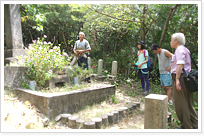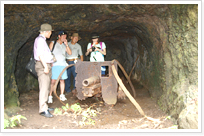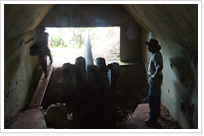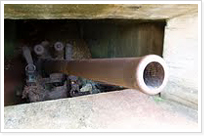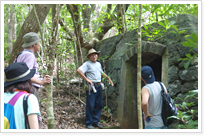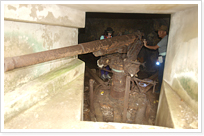Old Battlefield Tour
- An authorized guide must accompany all visits into protected forest ecosystems.
| About 6½ hours | |
| About 8,000 yen | |
Towel, rainwear, camera
|
You're going to be walking through the woods. Eat a good breakfast.
9:00
Put on some comfortable, well-worn shoes, and go to meet your guide at the designated meeting place.
9:10
Ride in the guide's car to the naval cemetery in Okumura to comfort the spirits of the war dead.
Reach the entrance to Mt. Yoake (Yoakeyama). We are going to be walking around this mountain for about four hours. Listen to your guide, since there are many muddy spots to avoid, and many ups and downs. What kind of war remnants could there be, you think, hidden in these dense woods?
After walking a little along the mountain paths, you see the entrance to what looks like a cave. Borrow a flashlight from you guide, and head on in. The inside is damp and muddy, but surprisingly wide and long. The opening is about 5 meters (16 ft) wide and 4 meters (13 ft) high; and the tunnel goes around in a square with a total length of about 150 meters (492 ft). This is what remains of the headquarters of the navy's communications group. Follow the tunnel once around.
Exit the tunnel and continue walking through the woods. After awhile we come to a cannon mounted in a hole dug into the slope of the mountain. The installation makes clever use of the mountain's topology, and it's well hidden. The cannon is a 7.5-cm army mountain gun. Look into the barrel through the loading hole toward the back, and you'll see the rifled grooves along the interior.
Since the cannon is outdoors, it makes a good place to take some pictures.
When you look at the tunnel exit from the outside, you can see the thick concrete anchoring, and the long barrel of the cannon jutting out from the rectangular hole. This cannon guards Hatsune inlet (Hatsuneura), on the east side of Chichijima.
Yes, this is an old Japanese navy bunker, equipped with a 14-cm wide-coverage cannon. It seems quite formidable.
Listen for a while as the guide explains what you are seeing, and tells you about what happened when the cannon was rediscovered after the war had handed.
Return through the bunker and then out of the tunnel, and back into the woods. And now it's time to stop and eat lunch.
But, really, these woods on Mt. Yoake seem endless.
We come across many ruins: a barracks, an officers' meeting room, a kitchen, and more. We stop at each, and the guide explains.
Not all of the remnants we see are so clear. Sometimes the remains of a building are obvious; sometimes we have a little doubt about what we're looking at; and sometimes we really have no idea at all.
But all of us share a deep sense of how difficult it must have been for the soldiers here on this mountain.
And here's still another tunnel. We're getting rather accustomed to going into these things. But even so, the length of this one is quite impressive. At the exit side is another bunker. This one looks out at Ōgi inlet (Ōgiura), on the west of the island-the side opposite from the previous bunker. The artillery is a Type 88 7-cm antiaircraft gun.
So with this antiaircraft gun, and the 14-cm cannon on the other side, we can sense how important this mountain position must have been to the fighters here. From this location you can look out at both the east and west sides of the island. It was inevitable that they would turn this mountain into a fortress.
We take some pictures here, then return along the road we came on.
The guide again explains the various ruins and remnants we see as move through the woods. Finally we get back to the place where we got out of the car this morning. This concludes our exploration of the battle sites on Mt. Yoake.
We spend the remaining time looking at the ruins of the first headquarters of the navy's communication group (they moved from here to the first tunnel we visited today due to war conditions). We also come and look out from the observation platform at the wreck of the transport ship Hinkomaru, still sitting in Sakai inlet (Sakaiura) on the island's east side. In June 1944, damaged by a torpedo from an American submarine, this ship limped back to the shoals of this inlet, and came to rest where it remains today.
15:30
The end of the tour, and we go our separate ways. Today Chichijima is a place of peace. And the town is welcoming.
